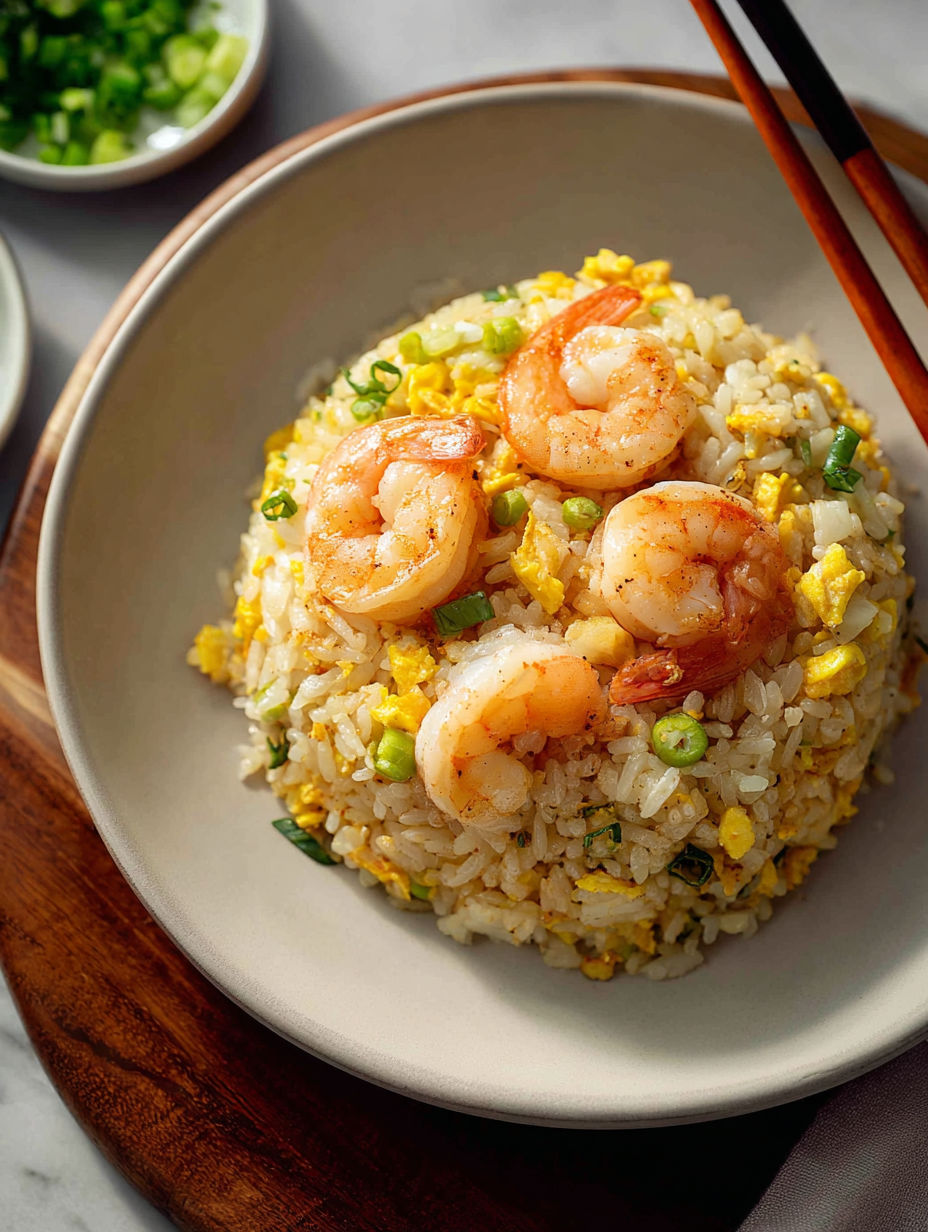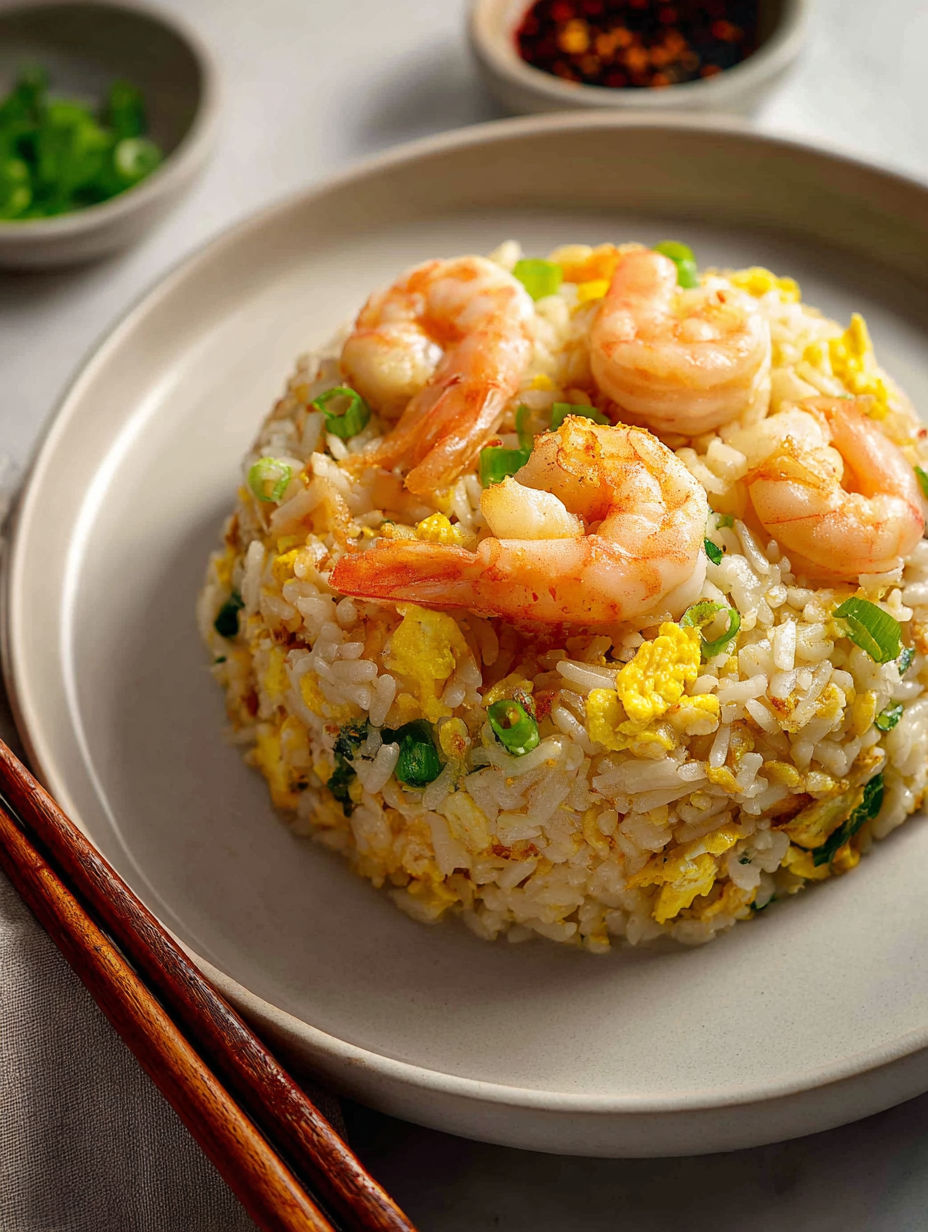 Save
Save
This shrimp fried rice strikes the perfect balance between quick weeknight convenience and satisfying comfort. It transforms simple ingredients into a flavorful meal with a great mix of textures.
I started making this after realizing leftover rice could be a star, not a side, and it quickly became a household favorite on busy nights.
Ingredients
- Shrimp: shelled and de‑veined provides tender protein, choose fresh or properly thawed frozen shrimp
- Salt: enhances natural flavors and balances seasoning throughout the dish
- Cornstarch: helps the shrimp develop a slight silky coating that seals in juices
- Oil: for stir-frying ensures even cooking and helps achieve the perfect wok hei aroma
- Eggs: beaten and gently scrambled add creamy texture and boost protein content
- Day‑old white rice: works best because its drier grains toast nicely and avoid clumping
- Sesame oil: adds a toasted nutty undertone, opt for a good quality, cold-pressed variety
- Chicken bouillon powder: contributes a rich savory depth, check for low sodium if preferred
- Sugar: balances savory and salty elements enhancing overall flavor harmony
- Scallions: provide fresh bite and bright color, select firm stalks with vivid green tops
Instructions
- Build The Flavor Base:
- Combine shrimp with salt and cornstarch then toss well, letting it marinate for about ten minutes. This step helps the shrimp stay juicy and develop a slight velvety texture once cooked.
- Cook The Eggs:
- Heat one tablespoon of oil in a wok or large skillet over medium heat. Pour in beaten eggs and gently scramble just until set but still softly runny inside. Remove eggs from pan to avoid overcooking. This keeps them tender and slightly creamy.
- Sear The Shrimp:
- Add another tablespoon of oil to the pan. Place shrimp in a single layer and cook for one to two minutes per side until they turn opaque pink. Removing them immediately prevents toughness.
- Toast The Rice:
- Add last tablespoon of oil and then the day-old rice. Break up any clusters with a spatula while stir-frying for one to two minutes until warmed through and slightly toasted. This step ensures each grain has a pleasant chew.
- Combine And Finish:
- Return eggs and shrimp to the wok. Drizzle sesame oil then sprinkle chicken bouillon, salt, sugar, and scallions over the top. Toss everything quickly and evenly for 30 seconds to a minute until well combined and heated through. Taste and adjust seasoning before serving right away for best texture and flavor.

Storage Tips Store any leftovers cooled in an airtight container in the refrigerator for up to three days. Reheat gently in a skillet or microwave adding a splash of water to refresh the rice's texture. Avoid overcooking during reheating to keep shrimp tender.
Ingredient Swaps
Use frozen shrimp if fresh is unavailable just thaw and pat dry first. You can swap white rice for brown rice though cooking times will increase slightly and the texture will be heartier. Try turkey or chicken breast cubes as an alternative protein.
Serving Ideas
Serve with a side of pickled vegetables or a simple cucumber salad for a refreshing contrast. Garnish with extra scallions, a drizzle of soy sauce or a wedge of lime for brightness. It also pairs well with steamed greens or stir-fried bok choy.
Cultural Context
Fried rice has roots in many Asian cuisines as a clever way to repurpose leftover rice and ingredients. Shrimp adds a festive element often seen in celebratory dishes. This recipe balances traditional flavors with the convenience needed for modern home cooking.

This shrimp fried rice is a quick, flavorful meal that elevates simple ingredients effortlessly.
Frequently Asked Recipe Questions
- → Why use day-old rice for this dish?
Day-old rice has less moisture, which prevents clumping and helps achieve a light, fluffy texture when stir-fried.
- → Can fresh shrimp be used?
Yes, fresh shrimp can be used; just ensure they are shelled and de-veined and marinated briefly for best flavor.
- → What is the role of cornstarch in the marinade?
Cornstarch helps create a slight coating on the shrimp, which locks in moisture and results in a tender texture after cooking.
- → Is sesame oil necessary?
Sesame oil adds a distinct, nutty aroma and flavor that complements the other ingredients; a small amount greatly enhances the dish.
- → Can vegetables be added to this dish?
Absolutely, additions like peas, carrots, or bell peppers can bring extra color, texture, and flavor to the dish.
